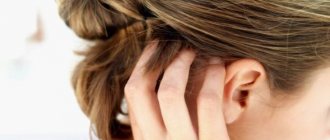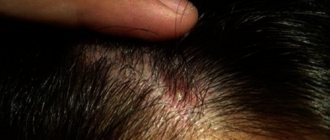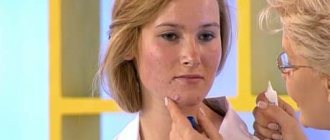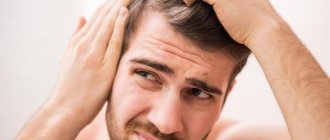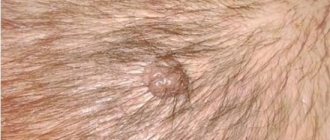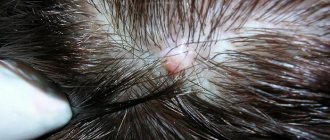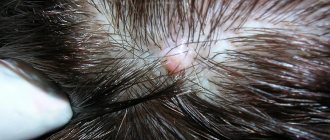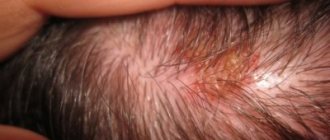Dropping out
Author Alexey Ozhogin
Date
May 25, 2016
6,526
Share
For many years, medicine has been studying the causes of acne and ways to combat it. This defect occurs equally in women and men. Children are no exception either. Acne is not a typical aesthetic disorder, but a serious disease. The appearance is accompanied by redness and pain.
Pimples on the scalp occur in women and men
- Acne appeared on the head, neck and back: treatment methods for women and men
- 7 reasons why painful blisters appear on the skin in curls
- If purulent and painful pimples appear on the body of the head
- Large red and white blisters: analyzing the symptoms
- How to get rid of the problem for adults and newborn babies
Functions of the skin
First you need to remember what skin is and why a person needs it. It is an organ of sensory perception, as well as part of the immune system that prevents foreign substances and infections from entering the body. When a person’s immunity is reduced, the skin begins to peel, become covered with acne, blackheads, and quickly becomes oily.
The skin of the scalp differs in structure from the rest of the skin on the head, as it performs important functions. Due to the increased number of hair follicles, its blood supply follows a different principle. In addition, it is necessary to protect the brain from infections and heat loss.
Large red and white blisters: analyzing the symptoms
The location of the acne does not matter: at the edge of hair growth or on the scalp, the measures are identical. Stage one – comprehensive analysis:
- Harmful products can cause pimples on the head under the hair. Take a piece of paper and a pen, and now write down everything you eat. See if this list includes: chocolate, alcohol, smoked foods, pickles. If there is, then it is necessary, even if not completely eliminated, but at least minimized. Also add a regular multivitamin;
Eliminate harmful foods from your diet
Find out whether the cosmetic product is compatible with your skin.
And if the problem has already developed, then you need shampoo for acne on the head (sold at the pharmacy);
List of diseases: description and photo
Next, you can see in the photo what sores, red spots, wounds and other diseases look like, and also read about the reasons for their appearance on the scalp and hair.
Wounds and suppuration
They are the entry point for infection in the affected area. If pathogenic bacteria enter an open wound, infection occurs. The body isolates the infection, as if blocking it with a protective shell, after which the immune cells deal with it. But if the infection turns out to be strong, then the immune system will be slower to fight it, which can ultimately result in an abscess and suppuration.
Causes:
- Thermal damage (as a result of blow-drying, perm).
- Trichotillomania, a mental disorder in which a person independently pulls out his hair.
- As a result of chemotherapy.
- Lack of vitamins.
- Violation of water-salt balance.
- Diseases of the central nervous system.
- Frequent stress.
Peeling and crusting
These phenomena may be harbingers of:
- Development of seborrhea, which manifests itself as a greasy, yellow crust on the scalp. This is a common occurrence and may be a reaction to a disorder of scalp fat metabolism, an allergy to shampoos or soaps, or a response to certain types of medications.
- A fungal infection, the colonies of which flake off when dried with a hairdryer or in the sun and fall off on the shoulders and back.
- Presence of lice or other parasites.
- Ringworm. An infection whose bacteria feed on the epithelium, leaving the hair without a foundation.
- Eczema, psoriasis, seborrhea.
- Other skin diseases of an infectious nature, as well as cancer.
The appearance of wounds, blisters or tumors on the scalp may be due to the following reasons:
- Folliculitis (infection of the hair shaft).
- Allergic skin reaction (contact dermatitis).
- A viral infection, such as chickenpox or shingles.
- Skin disease, such as acne.
- Epidermal or sebaceous gland cyst.
Oncology
Cancerous growths can develop on the scalp, especially in areas where there is no hair. Cancer destroys skin cells, and in some cases it can metastasize to other parts of the body. Externally, skin cancer looks like a tumor, a mole, a permanent wound, or a spot. The most common types:
- basal cell skin cancer;
- squamous cell skin cancer;
- melanoma.
Pimples
Acne or rashes indicate a disruption of the sebaceous glands or water-salt balance. When the skin is too dry, increased amounts of sebum are produced to protect the scalp from infections and heat loss.
When there is any disturbance in the body, sebum is released uncontrollably and clogs the sebaceous glands. They become inflamed and turn into acne. Acne can also be caused by hormonal imbalances (in particular, an imbalance of sex hormones) that causes hypertrophy of the sebaceous glands.
If you have discovered a scalp disease that was not mentioned above, then click here and you will learn about other types of ailments.
Pimples in the hair on the head - causes of their appearance and methods of treatment
Pimples in the hair on the head can cause particular discomfort. They are not as noticeable, unlike localization in other parts of the body, but they are painful, small and inaccessible, which causes difficulties in treatment.
However, it is important to identify triggers early and treat them. The scalp quickly becomes dirty, so you need to choose effective methods of treatment.
First of all, therapy is local: ointments, talkers, gels, shampoos, creams.
Why do acne appear on the head?
Most often, the reasons are banal: abuse of fatty, sweet and fried foods, failure to comply with hygiene standards, lack of proper care for hair and scalp, which leads to irritation, itching, peeling, infection of the dermis with the development of an inflammatory process. Provoking factors can be external and internal.
External:
- rare (frequent) hair washing;
- incorrect selection of balms and shampoos that do not match the skin (hair) type, causing allergies;
- frequent skin contact with synthetics when wearing hats, using low-quality pillows, towels, washcloths;
- accidental damage to the skin with a razor, blade, or hair clippers, often leading to infection of the upper layers of the dermis in men ;
- exposure to high (low) temperatures;
- washing your hair with chlorinated water.
Internal reasons:
- stress;
- mental, physical fatigue;
- dysfunction of the sebaceous glands, leading to clogging of the skin;
- hormonal imbalance, lack of estradiol and increased testosterone levels, which often occurs in women during puberty;
- damage to the layers of the dermis by a fungal or bacterial infection
- excessive activity of the fatty glands, which contribute to the narrowing of the pores on the head and inflammation of the follicle canals;
- abuse of medications (barbiturates, steroids, hormonal synthetic drugs);
- smoking, alcohol;
- polycystic ovary syndrome, adrenal gland dysfunction, which is often to blame for stress.
If acne appears in the hair on your head, you should first of all think about revising your diet and stop consuming sweets. Eat more vegetables and fruits, foods with vitamins A and E. Take multivitamin complexes, avoid stress, since a rash on the head is the first sign of fatigue and overexertion.
Long-term use of medications has a negative effect on the skin, which leads not only to multiple rashes (pimples) on the skin, but also to the appearance of large blisters in the scalp.
Also, at first glance, the harmless effect of low temperatures, when people prefer not to wear hats in the frosty season, can result in the appearance of dandruff on the head, up to complete damage to the bulbous follicles and hair loss.
Pimples in hair
Purulent pimples are small bumps on the scalp, a sign of staphylococcal damage and the development of bacterial inflammation.
If at an early stage the pustules are small , insignificant and superficial, then as the inflammatory process develops, the lesion can lead to coverage of all follicles, merging of pimples with transformation into a single large lesion.
Red pimples in hair
The main reason is the addition of a bacterial infection with subsequent transformation into pustules after 2-3 days. Maybe it’s a herpes virus caused by Treponema pallidum, localized specifically on the scalp in the form of acne-like, dry pimples. Such red manifestations cannot be ignored. This is a reason to contact a trichologist.
Painful pimples on the head
If acne is painful , then the inflammation has probably spread to deeper areas of the dermis. If additional itching, burning, and irradiation of pain to nearby healthy areas are observed, then there is a high probability of suspecting the development of herpes zoster or herpes zoster.
Herpetic rashes on the head
When the herpes virus affects the scalp, it leads to pain, itching, and the appearance of numerous red blisters, followed by drying out and turning into sores covered with a yellow crust. Herpes is a contagious disease. It is caused by contact with a sick person - a carrier, or is it a consequence of weakened immunity, activation of herpes zoster upon penetration into the body.
How to get rid of acne in the hair on your head?
It is not easy to cure acne in the hair, because it is a sign of inflammation and requires comprehensive measures. First, you should visit a dermatologist and get tested. If the cause is an allergy, then you will need to consult an allergist. If - in diseases of the endocrine system, then an endocrinologist. Also, acne on the head of women can be caused by gynecological problems.
Treatment is comprehensive with mandatory adherence to a diet, avoidance of fatty, sweet, smoked and canned foods. It is worth equipping the diet with fermented milk foods, fruits, vegetables, and cereals. It is important to stop using artificial decorative cosmetics and other irritating compounds.
If pustules appear, itching and severe irritation on the head bother you, then to get a quick desired effect, it is better to have an effect using 2-3 compounds at once (masks, rinses, fatty ointments, antibacterial shampoos, special scrubs).
Effective medications for treatment of acne in the scalp:
- antibacterial agents (Ofloxacin, Dixicycline, Zatrin, Tetracycline, Amoxicycline, Ceftriaxone) in the case of localized pustular rashes on the scalp caused by a bacterial infection;
- antifungal drugs (Fluconazole, Levorin, Nystatin, Pimafucin) for fungal infections;
- sorbents (white coal, Smecta, Enterosgel, Polysorb) to suppress the activity of bacteria, accelerate the removal of allergens and toxins from the intestines to the outside in case of eczema, dermatitis, acne on the skin;
- external agents (Tsindol mash, camphor alcohol, salicylic, zinc ointment) to suppress opportunistic microflora and prevent subsequent proliferation of infection;
- antihistamines (Erius, Zodak, Cetrin, Loratadine, Telfast) in case of acne on the head caused by allergies;
- vitamin complexes containing selenium, zinc, vitamins A, B, E to saturate the dermis with useful microelements;
- antibiotics (Erythromycin, Clindamycin);
- retinoids (Adapalene, Differin, Baziron);
- special shampoos (Algopix, Nizoral).
In addition, to completely cure acne and pimples on the hair on the head, physical procedures can be effective: galvanization, ultraviolet light, vacuum inlay.
Shampoo for acne on the head
A medicated shampoo to get rid of acne should match your hair type and have a gentle, gentle hypoallergenic effect on the hair follicles. The TOP 5 best shampoos that have earned recognition and respect among users include:
- Nizoral is an antifungal shampoo that is effective for use at the early stage of the appearance of comedones and acne against the background of a bacterial (fungal) infection.
- Skin cap for acne on the head caused by allergies with an anti-inflammatory, anti-allergenic effect.
- Sulsena to remove acne or prevent its reappearance. The active component is selenium disulfide, which suppresses bacterial flora and accelerates the process of removing subcutaneous sebum. The drug can be used as monotherapy. Acne and rashes disappear after 10-14 days.
- Sebozole is combined with ketoconazole, which perfectly suppresses fungal infections. Indications for use: acne of various origins, psoriasis, seborrhea.
- Tar 911 is a shampoo with birch tar in its composition, which has earned recognition among consumers, quickly eliminating a specific rash (dermatitis) on the scalp, regulating the secretion of subcutaneous sebum, and preventing the spread of pathogenic microflora to healthy areas of the body.
Ointment for acne in hair
Ointment is the most convenient form of release when applied to the scalp with a drying, anti-inflammatory, antibacterial effect. It will quickly relieve itching and irritation, activate the sebaceous glands, and cleanse the pores of accumulated toxins and impurities. The best preparations, despite the presence of a greasy base, after which you have to wash your hair more often:
- gentamicin with an antibiotic effect to combat different strains of bacterial infection (streptococci, staphylococci);
- syntomycin - an excellent antibiotic for suppressing pathogenic microflora with targeted application to pimples, thereby preventing the growth and reproduction of pathogenic microflora;
- salicylic acid to relieve inflammation, applied locally, daily 1-2 hours before washing your hair;
- ichthyol with rapid elimination of pustular lesions, providing an antibacterial effect, despite the specific odor. The skin should be treated shortly before washing your hair (1-2 hours).
Before using any drug, it is wise to first test it for allergies by applying a little on your wrist and waiting 15-20 minutes.
To enhance the effect, you can treat the scalp with a solution of salicylic acid or camphor alcohol, rubbing it into the affected areas with massaging movements.
Leave for 2-3 hours, then wash your hair using a natural antiseptic (tar) to normalize the functions of the sebaceous glands and suppress pathogenic microflora.
Pimples on the head, treatment with folk remedies
People know many different recipes for getting rid of acne and cleansing the dermis of comedones. Of course, it is better to use folk remedies in consultation with a doctor and only for uncomplicated rashes at the initial stage. To help - masks, talkers, solutions (water, alcohol) for rinsing hair containing vegetables, fruits, and medicinal plants. Best recipes:
- Mask, lemon juice (2 tsp) mixed with olive oil (2 tsp). Lubricate the affected areas, cover your head with polyethylene, leave for 1 hour, rinse with water and shampoo.
- Grate the cucumber, rub the paste into the scalp, and cover with cellophane on top. Leave as a compress for up to 30 minutes, then rinse your hair with warm water without using shampoo.
- Pour anise seeds (100g) with warm water, leave for 12 hours, grind into a paste. Treat the skin, covering the top with film. Leave for 1 hour, then rinse with water. Apply masks after 1-2 days. The course of treatment is 14 days.
- Dandelion, prepare a decoction. Rinse after each shampoo, alternating with a decoction of chamomile, sage, and yarrow.
- Homemade shampoo. Mix colorless henna (2 tbsp) with water (2 tbsp), beat in 1 egg, mix. Apply to hair with massaging movements, leave for 1-2 hours, then rinse with warm water.
- Viburnum - crush the berries, squeeze out the juice. Treat problem areas for up to 40 minutes, then rinse with chamomile decoction.
- Mix vinegar with water (100 ml), apply to washed hair, leave for 5 minutes, then rinse well without shampoo.
As a rinse, you can use a decoction of yarrow, calendula, St. John's wort, sage, hop cones, celandine or chamomile, alternating them to enhance the effect.
To ensure that the scalp always remains healthy and acne does not bother you, it is important to follow simple preventive measures for every day :
- to refuse from bad habits;
- use natural scrubs when caring for hair and scalp;
- suppress stress and overexertion;
- use proven shampoos taking into account your hair type;
- wash your hair no more than 2 times a week;
- follow a diet;
- undergo regular examinations with doctors at least once a year;
- wear properly sized hats made from natural, breathable materials.
The rules are simple and will help prevent discomfort in the hair on your head. If the first signs of acne cannot be avoided, then it is important to choose the best proven remedies and, of course, visit a specialist. Pimples in the hair on the head are not always a harmless cosmetic defect. Often a sign of the development of internal, and serious, pathology.
You may also like
Source: https://KozhaLike.ru/pryshhi-v-volosah-na-golove/
Pityriasis versicolor
Pityriasis versicolor is a chronic dermatosis of fungal etiology that affects only the top layer of the skin. This form of lichen is also called lichen versicolor because it is characterized by the appearance of spots of various colors (from pale pink to dark brown).
The spots are covered with small scales that appear when scratching the affected areas. The lesions have clear edges, but tend to merge to form large areas of damaged epidermis. The disease is accompanied by itching and increased sweating.
It is diagnosed using an iodine test, skin scraping microscopy and under a Wood's fluorescent lamp.
Treatment occurs by prescribing antifungal ointments, and in severe cases, antifungal antibiotics. Among the traditional methods of treatment, calendula tincture, onion juice, and hellebore water are widely used.
Pityriasis versicolor affects only the top layer of skin
Self-removal of ulcers
First, a person must pay attention to his diet. Most often, the disease appears in those who love sweets, so it is necessary to reduce the absorption of sweet foods. Avoid drinking coffee, alcohol, smoked and salty foods.
The components of such products activate the sebaceous glands. As a result, pores become clogged. Inflammation appears, appearing in the form of ulcers. By adhering to proper nutrition, you can improve your gastrointestinal tract. The result will be the elimination of acne and pimples.
For small ulcers, tar soap is used. Thanks to it, the skin is cleansed. During the procedures there will be no drying or irritation, but, on the contrary, blood circulation will improve and wounds will heal. A proven method is to use a hot salt bath with sulfur.
How do sores on the head appear?
Sores on the head appear in the form of red crusts, small bumps, bleeding ulcers, dandruff, purulent pimples, neoplasms covered with white scales, spots or nodes of various sizes and shapes.
Their appearance may be accompanied by itching, or may be asymptomatic.
But it is important to understand that such formations are not just cosmetic or hygienic defects, they can be manifestations of a wide variety of diseases.
Psoriasis is a non-infectious skin disease of an autoimmune nature.
Which doctor can help?
If your scalp does not clear up after using the methods described, you should consult a doctor. With this problem you need to go to a professional dermatologist - he will conduct tests and give a verdict.
REFERENCE : A dermatologist is a highly specialized doctor who treats skin diseases.
However, treating blisters under the hair is not limited to visiting a single specialist. Most likely, you will have to visit a therapist, neurologist, endocrinologist and allergist.
You can read about the types of inflammation on the body on the hiring website, as well as about treatment methods. Among other things, we bring to your attention the following articles:
- is it possible to pierce them;
- blisters with fluid;
- treatment of a burn with a blister;
- cases of frostbite;
- appearance after wart removal;
- and also what to do if you itch and treatment for burns.
Allergic dermatitis
Allergic dermatitis is a skin disease that occurs when the skin comes into direct contact with substances that cause allergies.
Source: https://TvoyKrem.ru/pryshchi/gnojnichki-na-golove.html
Reasons for appearance
The most common cause is poor hygiene or the use of too many chemicals. This effect can also occur due to contact with stray animals.
Both infrequent and frequent hair washing can cause problems with fat metabolism in the scalp. This fat is called “sebum”; it contains substances that protect the scalp and prevent infection from entering the body.
ATTENTION! Vitamin C deficiency can cause serious problems with the immune and nervous systems, which lead to chronic fatigue. In this case, peeling of the skin is only a signal of a more serious illness.
Treatment methods
Treatment of herpes on the head in the hair should be started when the first signs of the disease appear. In the fight against this infection, both drug therapy and traditional medicine can be used.
Treatment of herpes simplex
The treatment of herpes on the head must be taken seriously. If you consult a doctor in a timely manner, the disease does not cause any complications. Herpesvirus therapy is based on the use of antiviral and anti-inflammatory drugs. Antiviral drugs include Acyclovir, Famciclovir, Valacyclovir. Anti-inflammatory drugs include Paracetamol, Ibuprofen.
1
2
Treatment may also require:
- subcutaneous administration of an antiherpetic vaccine (the regimen and dose are determined by the doctor);
- take drugs that enhance immunity;
- treat burst blisters with miramistin or panthenol several times a day;
- use erythromycin ointment, which heals ulcers at the stage of scab development;
- use of an ointment with an analgesic effect;
- physiotherapy - ultraviolet rays and a quartz lamp can destroy the virus.
You can get rid of herpes on the scalp if you follow all the doctor’s recommendations. Only comprehensive treatment will help stop the progression of the disease and prevent further complications.
Treatment of herpes zoster
The patient should be hospitalized only if there is a threat of brain damage. The development of Herpes-Zoster on the head causes discomfort in an adult, so therapy is based on reducing pain and preventing secondary infection. Just like for herpes simplex, the following medications are prescribed:
- antiviral;
- anti-inflammatory;
- painkillers;
- increasing immunity.
For unbearable pain, doctors prescribe the following additional measures:
- Blockade. The manipulation consists of injecting painkillers into the nearby soft tissue of the nerve affected by the disease. After the procedure, the patient feels relief for some time.
- Electrical nerve stimulation. The purpose of the procedure is to normalize the functional activity of nerve endings and eliminate pain.
When the virus affects the nerve branches, symptoms appear in the form of: constipation or diarrhea, urinary incontinence, paralysis or numbness in different parts of the body. For such complications, the doctor prescribes narcotic analgesics.
To treat herpes on the head, in particular, in the treatment of herpes zoster, you can use not only medical remedies, but also traditional methods. They involve the use of various tinctures that need to be consumed internally and the application of compresses to the affected area, soaked in a special decoction of medicinal herbs. You must discuss all your actions with your doctor. Only the right treatment can get rid of the infection.
First aid
How to cure scalp diseases and where to start treatment? First of all, you need to avoid contact of alcohol and acid with the affected surface, treat the wound with chlorhexidine or natural antiseptics (aloe juice, burdock or avocado oil).
- If there is an open wound on your head, apply antiseptic cream and cover with a bandage.
- If the skin is peeling, treat with moisturizer or ointment.
- Pimples, blackheads, and acne should absolutely not be squeezed. An open wound is very vulnerable to infection. You can wipe with alcohol or salicylic acid.
- Itching is a sign of allergies or parasites. To eliminate it, you can take an antihistamine. If you scratch the itching area, a scratch will form there, which may allow infection to pass through. You can learn about other precautions against itchy scalp that will help prevent complications in the form of various rashes and sores by clicking here.
- A crust on the head may be the result of a healing wound. Do not pick or scratch. You either need to do nothing or apply a nourishing skin balm.
- If you have a growth on your head, you cannot tear it off or treat it. It can be either an ordinary mole or a cancerous tumor.
It is recommended to consult a specialist as soon as possible, as some diseases may worsen over time.
What to do if red spots appear?
This is a clear sign of an inflammatory process or an allergic reaction.
- Can be treated with antiseptic ointment or cream.
- Can be treated with benzyl benzonate.
- You need to contact a mycologist for further diagnosis and treatment, because fungal infections and lichen usually itch.
Treatment for peeling
In this case, the main cause is a lack of vitamins or nutrients, dehydration, alcohol abuse or smoking. Peeling is also observed due to diseases of the immune or lymphatic system. In this case, you need to contact a dermatologist.
What to do with wounds after dyeing
The reason is intolerance to the components of the composition, poor-quality paint or chemical burn.
If your scalp feels hot when touched and sensitivity to temperatures is increased, you have a burn. You need to contact a dermatologist or therapist who will prescribe an anti-inflammatory drug. You should not self-medicate, because the paint toxin can react with some medications, which will aggravate the situation.
Herpes scalp
This disease proceeds similarly to other forms of herpes, differing only in localization.
Causes
Herpes occurs due to infection with a strain of the HSV-3 virus. Interestingly, this same virus causes chickenpox. Therefore, infection with herpes can occur not only due to contact with a carrier of the virus, but also as a complication after chickenpox. The second option is most common in adults.
However, it is worth remembering that herpes is directly contagious, so you should not touch the patient’s hair, use his comb or other objects that touch the hair. For infection, just one drop of liquid from a burst herpes bladder is enough, which can enter the bloodstream through a micro-scratch on the skin.
Symptoms
Doctors distinguish 4 stages in the development of the disease:
If you do not intervene during the course of the disease, symptoms disappear 2-4 weeks after their onset. For some patients, the discomfort may last much longer.
One of the complications may be loss of sensitivity in the scalp. Therefore, although herpes is considered a common disease, it is still worth seeing a doctor.
Treatment
If you consult a doctor, the treatment period is reduced to 1-2 weeks. Most often, the patient is prescribed the following drugs:
Herpes on the head in the hair treatment photo:
In order to speed up skin healing, the patient is advised to limit hair washing; only baby shampoo is allowed. Washing aggravates the course of herpes, so after the hygiene procedure it is necessary to treat the affected area with ointment.
Treating the affected areas with almond oil also speeds up healing.
